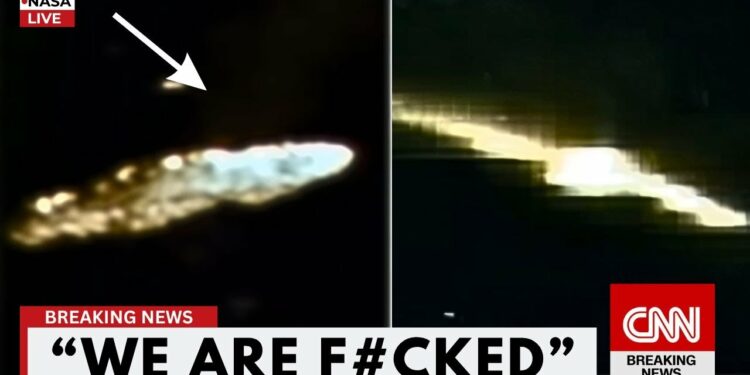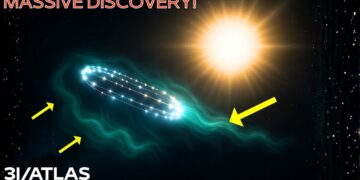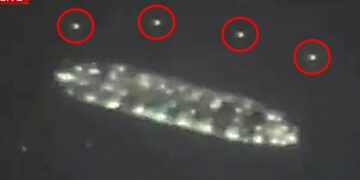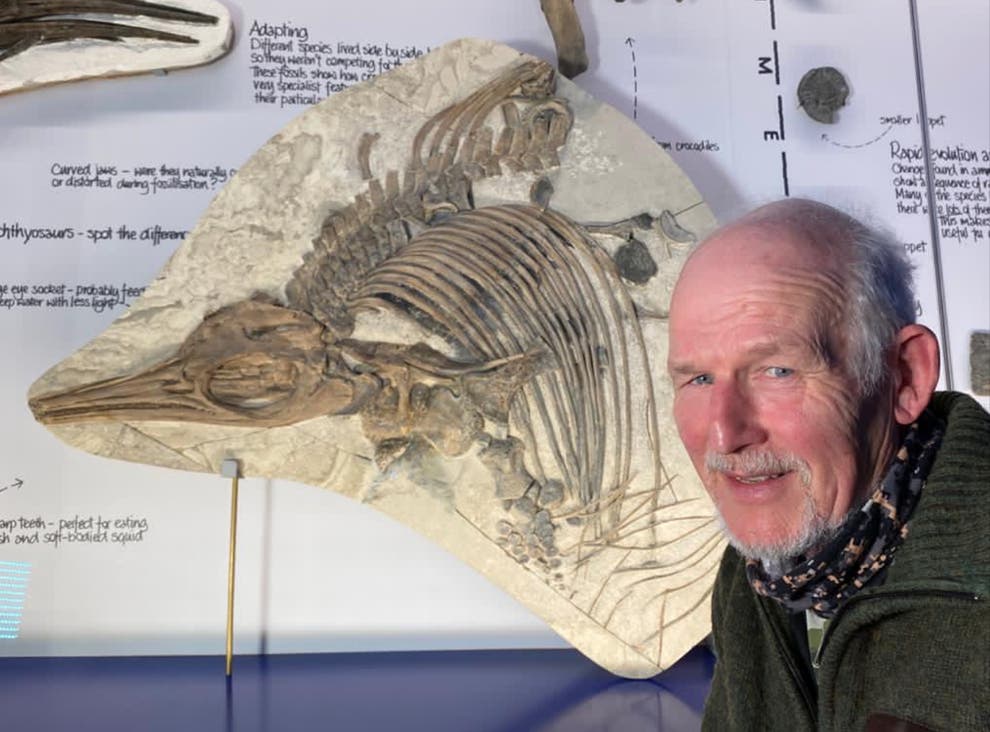Today, October 27, 2025, NASA released the clearest image ever captured of 3I/Atlas, sending shockwaves through the scientific community. The photograph, taken by the James Webb Space Telescope and corroborated by ESA’s Mars Express, reveals details previously unimaginable. The object’s glowing core does not behave like a typical comet. Rather than scattering light haphazardly, it pulses—slow, deliberate, and rhythmic—as if responding to an unseen stimulus. Within minutes of NASA’s release, the image proliferated across major news networks. Astronomers, researchers, and amateur stargazers alike hailed it as the most significant cosmic discovery of the century.
What has captivated the world is not merely the image itself, but its implications. 3I/Atlas appears to rotate with extraordinary stability, its spiral coma expanding in near-perfect symmetry. Data from observatories on Earth and Mars confirm faint energy spikes near the 1420 MHz hydrogen line—the same enigmatic frequency where the legendary Wow! signal was detected in 1977. This single detail has resurrected a 50-year-old mystery long thought resolved. Is it mere coincidence, or are we witnessing the return of something intentional? The timing, alignment, and behavior all seem too precise to dismiss. As new images stream in, the world holds its breath. Social media is inundated with speculation, theories, and profound wonder. Was 3I/Atlas always just a comet? Or is it something far more—a messenger, a vessel, or even a seed from another civilization?
For the first time in history, telescopes on two worlds—Earth and Mars—are observing the same object from opposite sides of space. The question is no longer what 3I/Atlas is, but why now? Why, after half a century of silence, has something from the same galactic region returned, pulsing, glowing, and seemingly gazing directly at us?
For months, the world tracked 3I/Atlas, the mysterious interstellar object hurtling through our solar system. Most early knowledge came from NASA, whose telescopes confirmed its anomalous speed and hyperbolic trajectory—proof of origins beyond our solar system. The James Webb Space Telescope analyzed its spectrum, detecting water vapor and carbon dioxide traces long before perihelion. NASA’s initial reports described it as unlike any known comet or asteroid. Then, abruptly, updates ceased.
On October 7, 2025, as NASA’s data streams went dark, the European Space Agency (ESA) intervened. ESA released the sharpest images of 3I/Atlas yet, captured not by deep-space telescopes but by the ExoMars Trace Gas Orbiter and Mars Express—probes orbiting Mars never designed for such tasks. Engineers pushed instruments beyond limits: adjusting software, extending exposures, and repurposing communications to detect a target over 100,000 times dimmer than usual.
The first image stunned the control room—a faint sphere of light enveloped in a shimmering misty halo against the void. It did not reflect sunlight like a comet; it glowed softly, as if alive from within. ESA publicized the photo within hours, calling it an “unexpected pattern of light behavior.” Simultaneously, NASA fell silent. The High Resolution Imaging Science Experiment (HiRISE) camera on the Mars Reconnaissance Orbiter—capable of the solar system’s sharpest planetary imaging—halted transmissions. No updates appeared on official channels; no explanation was given. The U.S. government shutdown was cited, but the timing fueled suspicion.
To the public, it seemed like a clash of worlds: ESA transparent and collaborative, sharing images and calibration files; NASA opaque and inaccessible. One agency gifted the mystery to humanity; the other closed its doors.
Curiously, NASA’s last pre-silence release showed the Perseverance rover capturing a faint streak in the Martian sky—likely 3I/Atlas on approach. NASA confirmed the sighting but withheld the high-resolution version. HiRISE could have imaged it with unparalleled clarity, yet when ESA’s photos emerged, NASA’s feed froze mid-update.
ESA invited global participation, publishing raw data and encouraging citizen scientists to process images. Buried in that data was an inexplicable detail: 3I/Atlas’s path was anything but random, its planetary alignments almost deliberate.
Astronomers plotting its orbit expected chaos from an interstellar interloper. Instead, it aligned nearly perfectly with the ecliptic plane—the disk of planetary orbits around the Sun—with a tilt of just 4.8989°. The odds of such alignment by chance: less than 1%. No prior interstellar object, including ‘Oumuamua or Borisov, had ever done so.
That was merely the start. 3I/Atlas passed near Mars, Venus, and Jupiter—the only planets ideally positioned for observation at that precise moment. Its Mars flyby occurred at 18.6 million miles when ESA orbiters were optimally placed. Weeks later, it neared Venus at Earth’s best viewing angle. By late October, Jupiter’s gravity aligned for a potential slingshot toward the Sun. To some, cosmic coincidence; to others, orchestrated.
One researcher dubbed it “the perfect flyby.” Simulations pegged the odds at under 1 in 10,000. Gravitational perturbations from stars or dust over eons might explain minor adjustments, but not this precision. Some quietly speculated non-accidental origins.
Public reaction intensified with ESA’s open-source data. Forums brimmed with orbital models tracing flawless planetary lines, like a programmed route. Headlines branded it “the most suspicious trajectory in modern astronomy.”
Yet the enigma deepened: 3I/Atlas was accelerating, soon exhibiting speed, light, and compositional changes no comet or asteroid could replicate.
From initial detailed data, 3I/Atlas defied comet norms. Its nucleus spanned 320 meters to 5.66 km—far larger than most comets, per July 2025 Hubble images. Despite shedding material, it exhibited minimal wobble or thrust from outgassing. Typical comets veer from vapor jets; here, implied acceleration was negligible, suggesting mass exceeding 33 billion tons.
Light reflection was bizarre: polarimetric data showed extreme negative polarization, minimum -2.77% at 6–7° phase angle—unprecedented in solar system comets, implying unique dust/ice grain shapes or compositions.
Chemistry was anomalous: abundant CO₂ early on, water ice grains beyond 6 AU (colder than typical comet activation), iron scarcity, and dust resembling trans-Neptunian objects more than comets. It mimicked a comet visually but not behaviorally.
Size, mass, reflection, and composition prompted questions: natural anomaly or something else? One astrophysicist called it a “record-breaker,” outmassing prior interstellar objects by orders yet behaving like a spacecraft, not an icy snowball. Most view it as natural but extreme; “unexplained” recurs in discussions. As it nears perihelion, expectation-reality gaps widen. New interstellar class, or rule-rewriting comet?
Next: a cinematic link to the 1977 Wow! signal. Mapping 3I/Atlas’s trajectory, its solar system entry was just 9° from the Wow! source in Sagittarius—a 72-second radio burst so potent Jerry Ehman circled it and wrote “Wow!” It vanished, unexplained by comets, satellites, or known phenomena.
Now, an interstellar object from nearly the same sky point, with uncanny timing and precision. Initially dismissed as coincidence, new Webb/ESA spectral data revealed faint 1420 MHz fluctuations—Wow!’s hydrogen frequency. Not transmissions, but light variations raising alarms.
SETI Institute comparisons projected the 1977 signal’s path intersecting 3I/Atlas’s 2025 emergence region. Eerie possibility: temporal connection?
Dismissals cited mimicry by radio noise/comet chemistry, but patterns seemed too pristine. The frequency is hydrogen’s natural line—a “universal calling card” for intelligent signals.
Harvard’s Avi Loeb posited: interstellar messages as objects, anomalies conveying meaning via motion. 3I/Atlas’s alignment and light could be the language.
Public forums compared events; coordinates overlapped on charts. Some saw “signal’s return,” others poetic rhyme. Both from the same galactic corner, defying natural explanations. Coincidence or connection, it revived: Are we alone, or reaching out?
Post-Wow! linkage, some theorized 3I/Atlas not communicating but creating—via planetary seed theory, transforming perceptions.
Life may spread via interstellar “seeds”—rock, dust, ice carrying microbes, molecules, or DNA precursors. Landing on suitable worlds sparks biospheres.
3I/Atlas data fit eerily: organics, methane, water ice; complex hydrocarbons from eons of radiation—a frozen time capsule.
Near-Sun behavior: not disintegrating but rhythmic gas bursts, like a heartbeat, dispersing carbon-water-rich particles in balanced clouds—ideal for seeding.
Models confirmed particle dispersal over vast distances. Solar system precedents: Mars meteorites on Earth with potential fossils. 2023 studies: bacteria survive millennia in space.
3I/Atlas could be natural or designed life-carrier. Skeptics: debris from collisions, not intent. But precision: backward trace to Kepler-452’s habitable zone with Earth-like planets.
If prebiotic, life isn’t Earth-unique but interconnected. Mystery shifts: not origin, but timing. Pulsing intensified—reacting to Sun or us?
Early October 2025: 3I/Atlas entered Mars’s orbital path, ~19 million miles away—unprecedented observation window.
Earth telescopes struggled with faintness; Mars vantage ideal, Sun behind object for glare-free view.
ESA reprogrammed orbiters: extended exposures, image stacking. Results: pale dot in soft haze—first interstellar images from another planet’s orbit.
Mars Express confirmed glowing core, faint tail; pulses, not random bursts. Matched Earth data.
Turning point: closest human instruments to an active interstellar object. Studied brightness, velocity, gas chemistry.
Post-flyby: stable course, no deviation—mass/structure beyond comets.
“Once-in-a-century” alignment of traveler and Mars tech.
Mars data: precise light flickers, excess carbon. No ordinary comet. What next?
ESA’s release sparked global race. 3I/Atlas: most scrutinized modern object.
Mars orbiters tracked inner-system progress: coma color/brightness shifts—internal changes.
Near-real-time processing; raw telemetry public—historic.
James Webb: 11-hour repeating flashes, heartbeat-like rotation. NASA confirmed silently—first post-blackout acknowledgment.
China’s Tianwen-1, UAE’s Hope: confirmed flashes, infrared gas data. Rival agencies collaborated unavoidably.
Late October: ESO/Alma radio scans—pulsed emissions, 11-hour pattern. Natural resonance or synchronization?
“Most international observation ever.” Amateurs joined via small telescopes, open-source analyses.
Global project transcending borders.
But NASA locked Webb telemetry; leaks of classified spectral patterns, unexplained frequencies—national security.
Insiders: beyond natural.
November: Loeb’s international committee call for interstellar research. Secrecy breeds fear; transparency reveals truth.
Movement for public data; 3I/Atlas: scientific freedom symbol.
New data: dramatic spiral coma expansion—unnatural. Hydrogen-line spikes, Wow!-tied.
Beyond object: humanity’s mirror—are we seeing nature or stellar message?
Final: Mars Express faint Earth-reflected pulse. Coincidence or response?
Months on, 3I/Atlas defies space knowledge: extrastellar origin, precise motion, intent-blurring chemistry. ESA proved presence; NASA silence questions. Reminder: universe vastly unknown. If one visitor, how many more await?























